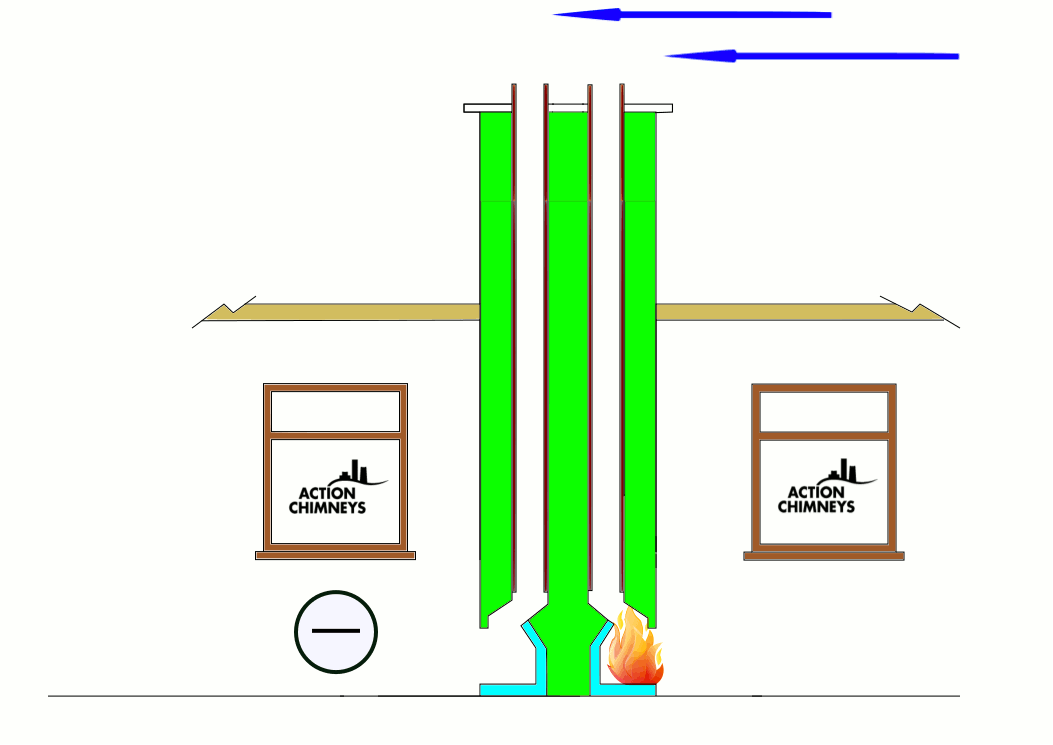Action Chimneys' comprehensive and specialist knowledge of chimney structure and geometry informs our ability to provide homeowners and commercial customers with the very best advice and recommendations. We are committed to providing our customers with an open, transparent and quality service. We listen to our customers and develop our service in response to your specific needs.
How a chimney works
Chimneys operate on the principle that hot air rises above cold air. The movement of hot gases rising from the fire creates a pressure difference between the inside of the flue and the room. This is called a “draught” and it forces air into the fireplace, this air feeds the flames as it rushes past the fire. The hotter the fire, the faster the air rises and the better the chimney works. The movement of air through the chimney is aided by the fact that air in the house is warmer than the air outside.
If the chimney is not working properly then sufficient draught will not be generated inside the flue and subsequently not enough air will be sucked into the fire for it to burn properly.
Although a chimney appears to 'suck', and smoke appears to naturally rise, it is more accurate to think of the weight of dense outside air pushing down to force air into the building and so push the hotter, lighter, waste gases out up the stack, somewhat like an air bubble rises in water.
It is the pressure difference between outside and inside a house that produces a draught
This tiny difference in pressure between inside and outside the flue is what makes a chimney function. Predicting the quality of flue draught for a chimney is very difficult and requires experience and a degree of technical knowledge.
What causes a downdraught
A downdraught is caused when air is blown back down the chimney. Typically this will result in puffs of smoke coming out of the stove or fireplace. Occasionally a smoking chimney problem can be incorrectly identified as having a downdraught issue when in fact this may not be the case. If the smoke is continuously coming down a chimney then this is not a downdraught. Downdraught is typically caused by a chimney that is either not high enough or where there are high buildings or trees nearby that affect the wind currents around the chimney. Quite often a downdraught will only occur in certain conditions, you might find that it presents on days when the wind comes out of the North that the stove smokes in puffs because of downdraught.
Wind Induced Downdraught can give rise to a situation where smoke from a shared chimney stack is blown down a nearby chimney that may not even be in use at the time. This can happen when a house has two flues sharing a single stack or two separate houses sharing a single stack.
The diagram on the right provides an insight into this phenomenon which is know as wind induced downdraught. Modern houses are becoming increasingly more airtight and as a consequence low pressure areas can easily exist in a room which in turn creates a vacuum which draws the fumes down the flue. This can lead to dangerous fumes entering an adjoining room or property and should be investigated immediately.
This problem can be managed through the installation of an adequate air vent or the use of specially designed chimney cowls that help deflect the wind away from the rising smoke. Action Chimneys can provide you with assistance should you experience this condition.
Wind induced downdraught
Dynamic Wind Loading is similar in effect to chimney wind induced downdraft but is created by pressure differences acting on different sides of a roof or house due to wind flow.
This causes a high pressure to develop on the windward side and a low pressure on the lee side. The low pressure results in a vacuum acting on any openings within the house such as an open window or door. A vacuum is created pulling air from the house causing a downdraft through the chimney as the house tries to replace the air being sucked out of it.
Dynamic wind downloading
Factors that impact on the quality of draught.
HEAT INSIDE THE CHIMNEY
The gases inside the chimney must stay very hot, or they will not rise. Although a small length, up to about 1m of uninsulated flue pipe may be acceptable directly from a stove, the entire length of the chimney above must be insulated, typically by thick masonry around an insulated ceramic liner or using prefabricated insulated components.
HEIGHT OF THE CHIMNEY
The higher the chimney stack, the more draught will be generated. For typical domestic chimneys and appliances in Britain and Ireland both the British Standard (BS 8303-1:1994) and Document J suggest a height of about 4.7 metres of straight, smooth, insulated chimney above the appliance. Less than perfectly sound chimneys will need to be taller to compensate. Special rules apply to Open Fires.
Exposed chimneys built on the exterior of a house will experience difficulty in retaining heat inside the flue as opposed to a chimney built on an internal wall.
AIR SUPPLY
There needs to be a route by which outside air can enter to replace the volume being lost up the chimney. While this can sometimes be provided by air leaking in through doors, windows etc., it is often necessary to fit a purpose-made air vent. An extractor fan, or another fuel-using appliance, even in a different room, can remove this air. Please refer to this video clip for additional information.
ROUTE
The entire route from fire to chimney terminal needs to be smooth, straight and vertical wherever possible. Where bends absolutely cannot be avoided, they should be very gentle, a maximum of 2x 45º and the chimney height increased by at least a metre to compensate. The flue needs to be absolutely sealed, without the slightest tiny crack at any point which might let cool air in. The flue needs to be big enough for the appliance being used.
Solutions to chimney downdraught issues
One only has to undertake a simple Google search for "chimney downdraught" to discover hundreds of devices that will claim to solve the downdraught problem. In our experience there is no single device on the market that will solve all the chimney problems that we have encountered. At present, we are in the process of field testing two new cowl designs that show great promise and have so far solved most of the issues that we have encountered. We intend to offer both of these cowls for sale on our site as soon as we have completed our trial and deemed them fit for purpose.




